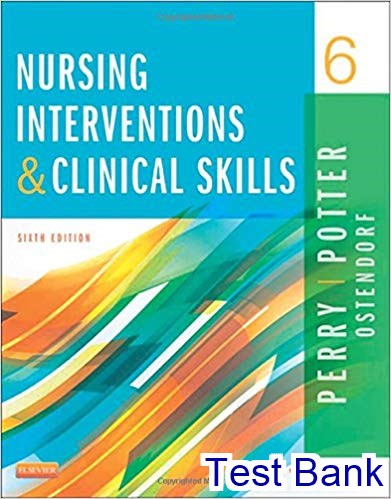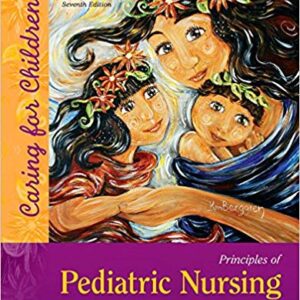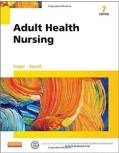Test Bank For Nursing Interventions and Clinical Skills 6th Edition By Perry
Table of Contents
Unit I: Quality and Safety in Nursing Practice Chapter
1: Using Evidence in Nursing Practice • Steps of Evidence-Based Practice • Evidence in Nursing Skills Chapter 2: Communication & Collaboration •
Skill 2.1 Establishing the Nurse-Patient Relationship and Interviewing •
Skill 2.2 Communicating with Patients Who Have Difficulty Coping •
Skill 2.3 Communications with Cognitively Impaired Patients • Procedural Guideline
2.1 Hand-Off Communications • Procedural Guideline
2.2 S-BAR Communication •
Skill 2.4 Discharge Planning and Transitional Care NEW!
Chapter 3: Documentation and Informatics • Procedure Guideline
3.1 Documenting Nurses’ Progress Notes • Procedural Guideline
3.2 Using an Electronic Medical Record • Procedural Guideline
3.3 Documenting an Incident Occurrence
Chapter 4: Patient Safety & Quality Improvement •
Skill 4.1 Fall Prevention in a Health Care Setting •
Skill 4.2 Designing a Restraint Free Environment •
Skill 4.3 Applying Physical Restraints •
Skill 4.4 Seizure Precautions •
Skill 4.5 Fire, Electrical, and Radiation Safety Chapter
5: Infection Control •
Skill 5.1 Hand Hygiene •
Skill 5.2 Applying Personal Protective Equipment •
Skill 5.3 Caring for Patients under Isolation Precautions •
Skill 5.4 Preparing a Sterile Field •
Skill 5.6 Applying Sterile Gloves Unit II: Patient Assessment Skills
Chapter 6: Vital Signs •
Skill 6.1 Measuring Body Temperature •
Skill 6.2 Assessing Pulse: Apical •
Skill 6.3 Assessing Pulse: Radial • Procedural Guideline
6.1 Assessing Pulse: Apical Radial •
Skill 6.4 Assessing Respirations •
Skill 6.5 Assessing Blood Pressure • Procedural Guideline
6.2 Assessing Blood Pressure Electronically Chapter
7: Health Assessment • Skill
7.1 General Survey • Procedural Guideline
7.1 Monitoring Intake and Output • Skill 7.2 Assessing the Head and Neck • Skill 7.3 Assessing the Thorax and Lungs • Skill 7.4 Cardiovascular Assessment • Skill 7.5 Assessing the Abdomen • Skill 7.6 Assessing the Genitalia and Rectum • Skill 7.7 Musculoskeletal and Neurological Assessment
Chapter 8: Specimen Collection • Skill 8.1 Urine Specimen Collection • Procedural Guideline 8.1 Collecting a Timed Urine Specimen • Procedural Guideline 8.2 Urine Testing • Skill 8.2 Testing for Gastrointestinal Alterations — Gastroccult Test, Stool Specimen, and Hemoccult Test • Skill 8.3 Collecting Specimens from the Nose and Throat • Skill 8.4 Collecting a Sputum Specimens • Skill 8.5 Obtaining Wound Drainage Specimens • Skill 8.6 Blood Glucose Monitoring • Skill 8.7 Performing Venipuncture
Chapter 9: Diagnostic Procedures • Skill 9.1 Contrast Media Studies: Arteriogram (Angiogram), Cardiac Catheterization, Intravenous Pyelogram • Skill 9.2 Care of Patients Undergoing Aspirations — Bone Marrow, Lumbar Puncture, Paracentesis, and Thoracentesis • Skill 9.3 Care of Patients Undergoing Bronchoscopy • Skill 9.4 Care of Patients Undergoing Gastrointestinal Endoscopy • Skill 9.5 Obtaining an Electrocardiogram Unit 3: Basic Human Needs
Chapter 10: Bathing and Personal Hygiene • Skill 10.1 Complete Bathing • Procedural Guideline 10.1 Perineal Care • Procedural Guideline 10.3 Oral Care • Procedural Guideline 10.4 Care of Dentures • Procedural Guideline 10.5 Hair Care – Combing, Shampooing, Shaving • Procedural Guideline 10.6 Nail & Foot Care • Procedural Guideline 10.6 Bed Making – Occupied • Procedural Guideline 10.7 Bed Making – Unoccupied and Surgical




